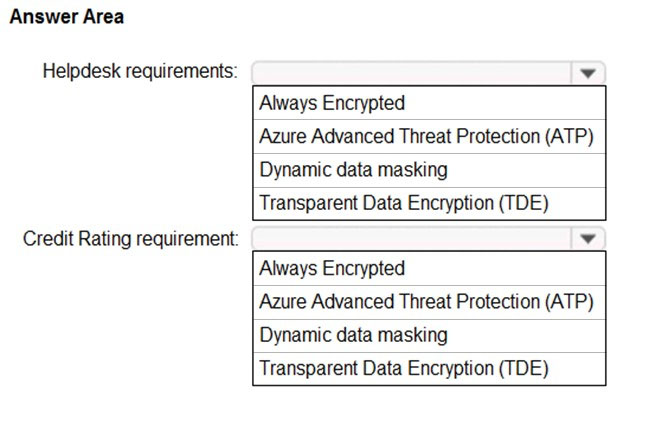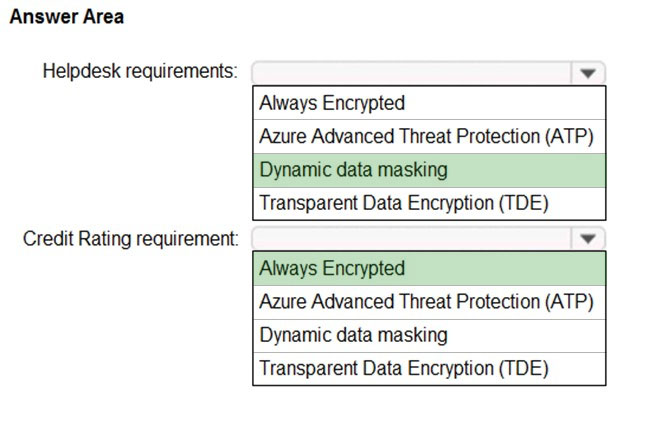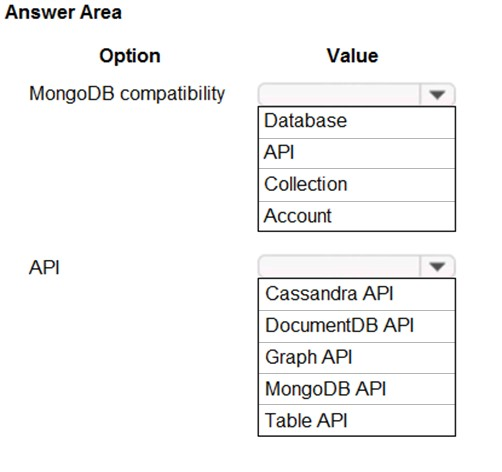Note: This question is part of a series of questions that present the same scenario. Each question in the series contains a unique solution that might meet the stated goals. Some question sets might have more than one correct solution, while others might not have a correct solution.
After you answer a question in this section, you will NOT be able to return to it. As a result, these questions will not appear in the review screen.
You are designing an Azure solution for a company that has four departments. Each department will deploy several Azure app services and Azure SQL databases.
You need to recommend a solution to report the costs for each department to deploy the app services and the databases. The solution must provide a consolidated view for cost reporting that displays cost broken down by department.
Solution: Create a resource group for each resource type. Assign tags to each resource group.
Does this meet the goal?
Answer:
A
Tags enable you to retrieve related resources from different resource groups. This approach is helpful when you need to organize resources for billing or management.
Reference:
https://docs.microsoft.com/en-us/azure/azure-resource-manager/resource-group-using-tags
Note: This question is part of a series of questions that present the same scenario. Each question in the series contains a unique solution that might meet the stated goals. Some question sets might have more than one correct solution, while others might not have a correct solution.
After you answer a question in this section, you will NOT be able to return to it. As a result, these questions will not appear in the review screen.
You are designing an Azure solution for a company that has four departments. Each department will deploy several Azure app services and Azure SQL databases.
You need to recommend a solution to report the costs for each department to deploy the app services and the databases. The solution must provide a consolidated view for cost reporting that displays cost broken down by department.
Solution: Create a new subscription for each department.
Does this meet the goal?
Answer:
B
Instead, create a resources group for each resource type. Assign tags to each resource
Note: Tags enable you to retrieve related resources from different resource groups. This approach is helpful when you need to organize resources for billing or management.
Reference:
https://docs.microsoft.com/en-us/azure/azure-resource-manager/resource-group-using-tags
Note: This question is part of a series of questions that present the same scenario. Each question in the series contains a unique solution that might meet the stated goals. Some question sets might have more than one correct solution, while others might not have a correct solution.
After you answer a question in this section, you will NOT be able to return to it. As a result, these questions will not appear in the review screen.
You are designing an Azure solution for a company that has four departments. Each department will deploy several Azure app services and Azure SQL databases.
You need to recommend a solution to report the costs for each department to deploy the app services and the databases. The solution must provide a consolidated view for cost reporting that displays cost broken down by department.
Solution: Place all resources in the same resource group. Assign tags to each resource.
Does the solution meet the goal?
Answer:
B
Instead, create a resources group for each resource type. Assign tags to each resource
Note: Tags enable you to retrieve related resources from different resource groups. This approach is helpful when you need to organize resources for billing or management.
Reference:
https://docs.microsoft.com/en-us/azure/azure-resource-manager/resource-group-using-tags
HOTSPOT -
You have an Azure SQL database named DB1.
You need to recommend a data security solution for DB1. The solution must meet the following requirements:
✑ When helpdesk supervisors query DB1, they must see the full number of each credit card.
✑ When helpdesk operators query DB1, they must see only the last four digits of each credit card number.
✑ A column named Credit Rating must never appear in plain text within the database system, and only client applications must be able to decrypt the Credit
Rating column.
What should you include in the recommendation? To answer, select the appropriate options in the answer area.
NOTE: Each correct selection is worth one point.
Hot Area:
Answer:

Box 1: Dynamic data masking -
Dynamic data masking helps prevent unauthorized access to sensitive data by enabling customers to designate how much of the sensitive data to reveal with minimal impact on the application layer. It's a policy-based security feature that hides the sensitive data in the result set of a query over designated database fields, while the data in the database is not changed.
Box 2: Always encrypted -
Data stored in the database is protected even if the entire machine is compromised, for example by malware. Always Encrypted leverages client-side encryption: a database driver inside an application transparently encrypts data, before sending the data to the database. Similarly, the driver decrypts encrypted data retrieved in query results.
Reference:
https://azure.microsoft.com/en-us/blog/transparent-data-encryption-or-always-encrypted/
You are designing a data protection strategy for Azure virtual machines. All the virtual machines use managed disks.
You need to recommend a solution that meets the following requirements:
✑ The use of encryption keys is audited.
✑ All the data is encrypted at rest always.
✑ You manage the encryption keys, not Microsoft.
What should you include in the recommendation?
Answer:
C
Reference:
https://docs.microsoft.com/en-us/azure/security/azure-security-disk-encryption-overview
You have an on-premises application named App1 that uses an Oracle database.
You plan to use Azure Databricks to transform and load data from App1 to an Azure Synapse Analytics instance.
You need to ensure that the App1 data is available to Databricks.
Which two Azure services should you include in the solution? Each correct answer presents part of the solution.
NOTE: Each correct selection is worth one point.
Answer:
BD
Automate data movement using Azure Data Factory, then load data into Azure Data Lake Storage, transform and clean it using Azure Databricks, and make it available for analytics using Azure Synapse Analytics. Modernize your data warehouse in the cloud for unmatched levels of
Note: Integrate data silos with Azure Data Factory, a service built for all data integration needs and skill levels. Easily construct ETL and ELT processes code-free within the intuitive visual environment, or write your own code. Visually integrate data sources using more than 90+ natively built and maintenance-free connectors at no added cost. Focus on your dataג€"the serverless integration service does the rest.
Reference:
https://azure.microsoft.com/en-us/services/databricks/#capabilities https://azure.microsoft.com/en-us/services/data-factory/
You have 100 devices that write performance data to Azure Blob storage.
You plan to store and analyze the performance data in an Azure SQL database.
You need to recommend a solution to move the performance data to the SQL database.
What should you include in the recommendation?
Answer:
B
You can copy data from Azure Blob to Azure SQL Database using Azure Data Factory.
Reference:
https://docs.microsoft.com/en-us/azure/data-factory/tutorial-copy-data-dot-net
HOTSPOT -
You have a web application that uses a MongoDB database. You plan to migrate the web application to Azure.
You must migrate to Cosmos DB while minimizing code and configuration changes.
You need to design the Cosmos DB configuration.
What should you recommend? To answer, select the appropriate values in the answer area.
NOTE: Each correct selection is worth one point.
Hot Area:
Answer:

MongoDB compatibility: API -
API: MongoDB API -
Azure Cosmos DB comes with multiple APIs:
✑ SQL API, a JSON document database service that supports SQL queries. This is compatible with the former Azure DocumentDB.
✑ MongoDB API, compatible with existing Mongo DB libraries, drivers, tools and applications.
✑ Cassandra API, compatible with existing Apache Cassandra libraries, drivers, tools, and applications.
✑ Azure Table API, a key-value database service compatible with existing Azure Table Storage.
✑ Gremlin (graph) API, a graph database service supporting Apache Tinkerpop's graph traversal language, Gremlin.
Reference:
https://docs.microsoft.com/en-us/azure/cosmos-db/create-mongodb-dotnet
You have 100 servers that run Windows Server 2012 R2 and host Microsoft SQL Server 2014 instances. The instances host databases that have the following characteristics:
✑ The largest database is currently 3 TB. None of the databases will ever exceed 4 TB.
✑ Stored procedures are implemented by using CLR.
You plan to move all the data from SQL Server to Azure.
You need to recommend an Azure service to host the databases. The solution must meet the following requirements:
✑ Whenever possible, minimize management overhead for the migrated databases.
✑ Minimize the number of database changes required to facilitate the migration.
✑ Ensure that users can authenticate by using their Active Directory credentials.
What should you include in the recommendation?
Answer:
B
Reference:
https://docs.microsoft.com/en-us/azure/sql-database/sql-database-managed-instance
Note: This question is part of a series of questions that present the same scenario. Each question in the series contains a unique solution that might meet the stated goals. Some question sets might have more than one correct solution, while others might not have a correct solution.
After you answer a question in this section, you will NOT be able to return to it. As a result, these questions will not appear in the review screen.
You have an Azure Storage account that contains two 1-GB data files named File1 and File2. The data files are set to use the archive access tier.
You need to ensure that File1 is accessible immediately when a retrieval request is initiated.
Solution: For File1, you set Access tier to Hot.
Does this meet the goal?
Answer:
A
The hot access tier has higher storage costs than cool and archive tiers, but the lowest access costs. Example usage scenarios for the hot access tier include:
✑ Data that's in active use or expected to be accessed (read from and written to) frequently.
✑ Data that's staged for processing and eventual migration to the cool access tier.
Reference:
https://docs.microsoft.com/en-us/azure/storage/blobs/storage-blob-storage-tiers